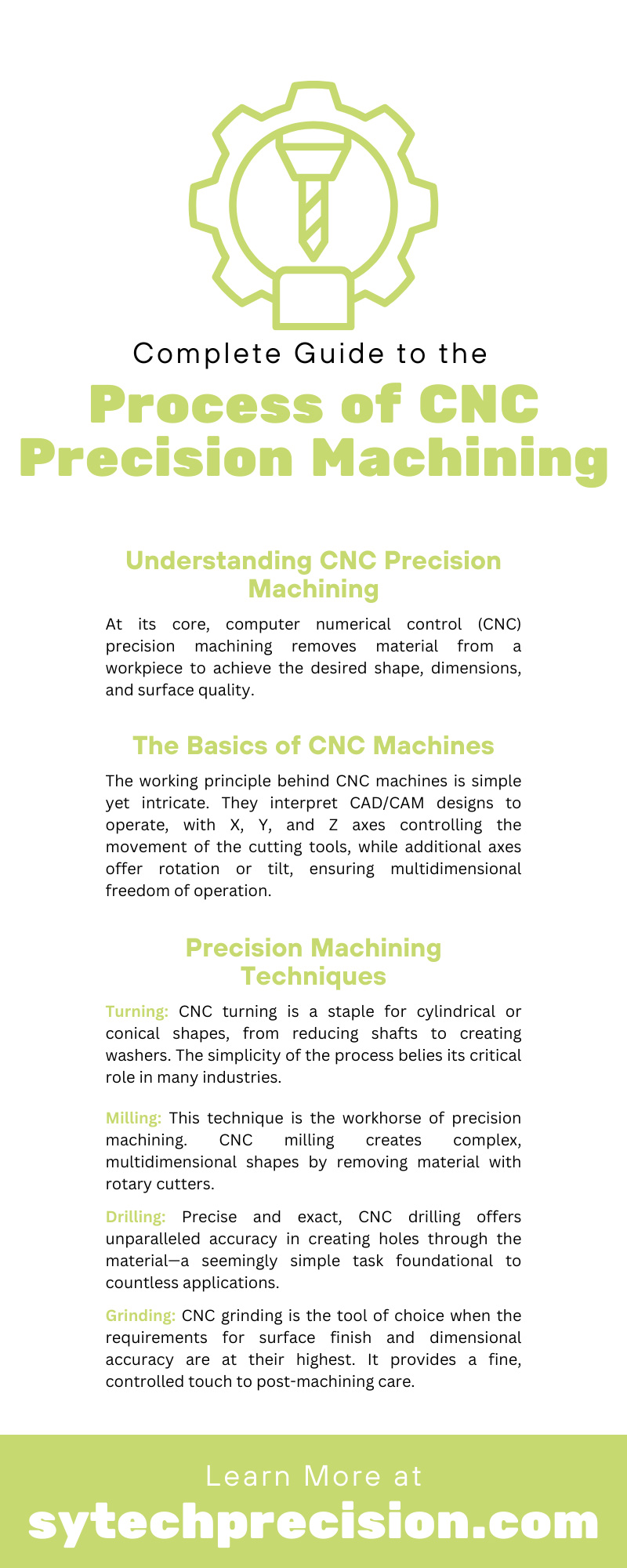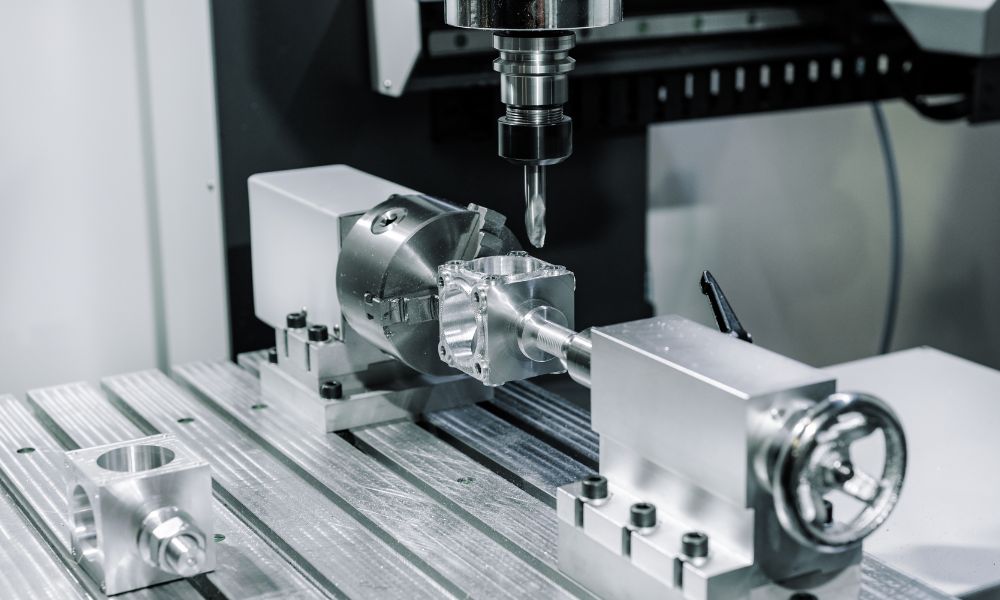The manufacturing industry is undergoing a precision revolution, where even the smallest measurements and moments are crucial. Enter the core of contemporary industrial prowess—CNC precision machining.
If you want to learn more about CNC precision machining process, our complete guide is here to help. Keep reading to learn more about CNC precision machining, from the basics of its machines to techniques, applications, and more.
Understanding CNC Precision Machining
At its core, computer numerical control (CNC) precision machining removes material from a workpiece to achieve the desired shape, dimensions, and surface quality. Unlike conventional machining methods that require manual operation of machinery, CNC machining comprises a set of preprogrammed commands that dictate the movement of cutting tools and other machinery, with the vast majority of operations being entirely automated.
Precision is the watchword here; from the initial design to the finished product, every step is carefully controlled to ensure accuracy and repeatability. The integration of CNC technology has dramatically influenced the trajectory of manufacturing by increasing the complexity and exactitude of components and reducing the margin of error and human interaction.
The Basics of CNC Machines
Before comprehending the nuances of precision machining, one must understand the fundamentals of CNC machines. The working principle behind CNC machines is simple yet intricate. They interpret CAD/CAM designs to operate, with X, Y, and Z axes controlling the movement of the cutting tools, while additional axes offer rotation or tilt, ensuring multidimensional freedom of operation.
These precision tools come in various forms, each tailored to a specific manufacturing need and process. The most common types include the following.
Milling machines: Utilizing rotary cutters, these machines remove material from a stationary workpiece. The process can be vertical or horizontal, and additional axes can produce incredibly complex geometries.
Turning machines: CNC lathes rotate the workpiece for circular components while a stationary cutting tool trims the material. This process is excellent for creating cylindrical shapes, threads, and more.
Drilling machines: Specially designed to bore precise holes in metal and other materials, these machines are pivotal to creating intricate workpiece channels and openings.
Grinding machines: This CNC variant is ideal for finishing operations, using abrasive grinding wheels to achieve high dimensional accuracy and surface quality.
Precision Machining Techniques
Machinists employ a variety of techniques to achieve the levels of precision demanded in advanced manufacturing.
Turning: CNC turning is a staple for cylindrical or conical shapes, from reducing shafts to creating washers. The simplicity of the process belies its critical role in many industries.
Milling: This technique is the workhorse of precision machining. CNC milling creates complex, multidimensional shapes by removing material with rotary cutters.
Drilling: Precise and exact, CNC drilling offers unparalleled accuracy in creating holes through the material—a seemingly simple task foundational to countless applications.
Grinding: CNC grinding is the tool of choice when the requirements for surface finish and dimensional accuracy are at their highest. It provides a fine, controlled touch to post-machining care.
Materials Used in CNC Machining
No discussion of precision machining is complete without considering the materials. CNC machines handle everything from soft plastics to hardened steel with equal aplomb.
Metals: Aluminum, stainless steel, and titanium are just the tip of the metallic iceberg. Each metal brings its machinability rating and grain to the table, altering toolpath recommendations in the process.
Plastics: High-density polyethylene (HDPE), acrylonitrile butadiene styrene (ABS), and polycarbonate are popular for CNC work due to their low weight, ease of molding, and affordability.
Composites: Fiberglass, carbon fiber, and Kevlar composites present their own challenges, with machining strategies often balancing strength and material density.
Advantages of CNC Precision Machining
The switch to CNC precision machining imparts numerous advantages, buoying the manufacturing world to new heights. With CNC, the possibility of human error is significantly reduced, leading to consistently precise parts with tight tolerances. Additionally, automated workflows mean machines can work 24/7, and material waste can be kept to a minimum with a carefully constructed toolpath. And last, every part produced by a CNC machine is identical to the one before, ensuring that products perform exactly as expected every time.
The Process of CNC Precision Machining
To take a product from concept to completion in CNC precision machining involves several steps, beginning with design and programming. CAD software creates a detailed design before the CNC machine even comes to life. CAM software then translates the design into the machine, precisely dictating every cut and tool change.
With the program set, the actual machining setup and execution can begin. This involves selecting the right tool, securing the workpiece, loading the program, and monitoring the process for quality checks and necessary adjustments. Stringent quality control processes ensure the product meets specifications.
Applications and Industries
CNC precision machining finds its way into an astonishing array of industries and applications.
Aerospace: The aerospace industry relies heavily on CNC machining for high-stakes and high-complexity parts, from turbine blades to landing gear. The ability to produce lightweight, durable components with tight tolerances is critical for safe and efficient flight.
Automotive: In auto manufacturing, CNC machines deliver the engines, transmissions, and chassis components that keep the industry moving forward.
Medical: CNC machining ensures the precision required for orthopedic implants, surgical tools, and diagnostic equipment.
Consumer electronics: Smartphones, laptops, and everything in between are bursting with tiny components made possible by micro-level CNC techniques.
Future Trends in CNC Machining
Automation: The natural progression of CNC technology points towards fully automated machining centers, reducing human intervention for less complex tasks and freeing human operators for more cerebral work.
Additive manufacturing: The lines between CNC and 3D printing are blurring, with hybrid technologies offering the benefits of both subtractive and additive approaches.
Enhanced interconnectivity: Interconnectivity and data-driven decision-making can revolutionize CNC machining, thanks to their better predictive maintenance and more streamlined production.
Enlist Sytech Inc.’s CNC Machining Services for Your Project
Hopefully, our complete guide to the delicate process of CNC precision machining has helped you learn more and appreciate the industrial craftmanship of CNC machining. For businesses seeking to stay competitive in industries where precision is not merely an advantage but a necessity, partnering with a proven leader in CNC precision machining is paramount. Sytech stands at the forefront of this technological revolution, blending unparalleled expertise with state-of-the-art equipment to deliver solutions that seamlessly align with your project’s specifications and timelines.
Whether you’re breaking new ground in aerospace, automotive, medical, or consumer electronics, our tailored precision machining services can propel your projects to the next level. Contact us today to explore how our cutting-edge solutions can transform your ideas into meticulously crafted realities.

